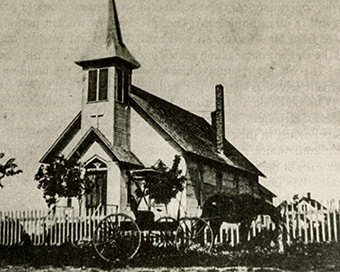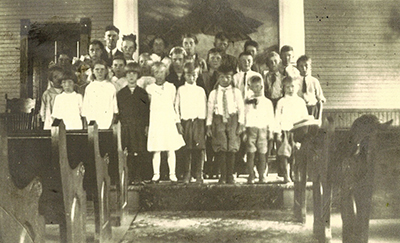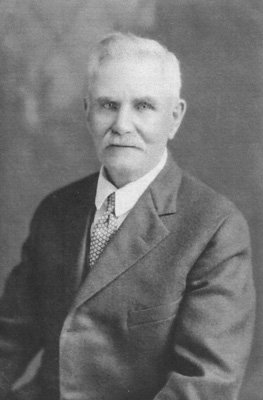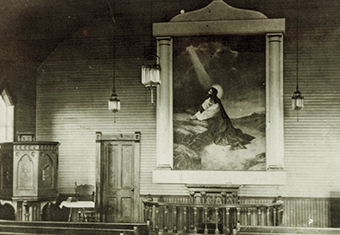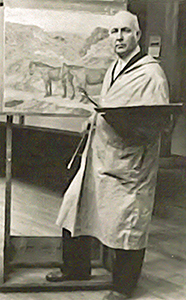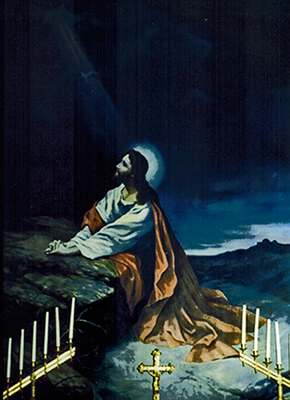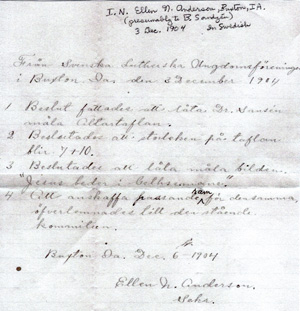
http://www.buxtoniowa.com • Consol, Haydock & Buxton Iowa, USA • 1871 - 2014
Ebenezer Lutheran Church and Famous Artist Birger Sandzen Painting Lost to Fire in 1954
“Ebenezer Burns 58 years ago - Ending last vestiges of Buxton” by Gordon Peterson published in the Albia Union-Republican on December 13, 2012
On December 20, 1954 the final death knell for the Monroe County Coal Camp of Buxton was written when fire destroyed the Ebenezer Lutheran Church in what was known as Buxton’s East Swedetown. East Swedetown was located at the southwest corner of what is now the intersection of 650th & 340th Streets.
For nearly 35 years, after most miners had left Buxton, in 1915-1918 to follow 20 miles to the southwest to the new mining camps of Consol, Camp 18, Bucknell and Haydock, the church continued to sit on the hill overlooking the west that was once Buxton. Between 1900-1915 the Consolidated Coal Co. owned-town had 2,000 homes and a population that exceeded 6,000 miners and their families. It covered an area of one square mile with many “suburbs” surrounding Buxton proper. Buxton’s “suburbs” included Coopertown, Gainestown and Hayestown.
The church was first built in the mid 1880’s and was located in the Muchakinock Coal Camp located just south of Oskaloosa. Swedish immigrants that that included Adolf Fredrick Nylander, my great grandfather, built the church. In 1900 after the coalmines were depleted in the Muchakinock are, the Consolidated Coal Company moved the coal camps 10 miles southwest to Buxton. My great grandfather followed the move to Buxton and he and other Swedish church members moved the church building to Buxton’s East Swedetown. The church until the fire was the last remaining functioning building other than 2-3 homes, including my grandparent’s home, from the coal mining ‘Buxton camp.’
The church was special to me since it was located behind my grandparent’s home that as a child in the 1950’s I would visit many summers from my home in Charles City. My grandparent’s house, known as the Bloom housing during the coal-mining era, is now owned by the Mark Keaton family. In the late 91940’s and early 1950’s after WWII my family had many Peterson/Nylander reunions at the home. They would include walking out the back door across the chicken lot to attend church services.
In spite of its small membership, the church continued to be the center of activities as it had been during the coal-mining era. In that era Swedish was heard as often as English as Swedish children would spend the major portion of their summer attending Swedish summer school in the church. The Swedes as all the other nationalities of that era were very religious, as with many other churches in Buxton.
My great grandfather was especially religious and forbade his son, Hjalmer Nylander, who played first base for the Buxton Wonders baseball team, to play baseball on Sunday. My grandfather and another Deacon of the church, a Buxton grocer named J.E. Larson, were known for their especially long religious teaching session. J.E. Larson was the brother of Linus Larson, the grandfather of Dave Larson of rural Albia.
It is sad that it was the celebration of Christmas that led to the fire that destroyed the church. While heating the church for a practice for the Christmas service, a fire started in the chimney. Not much was saved as the blaze spread rapidly in the wood-framed church. However, the church altar was saved. The altar is now at the St. Paul Lutheran Church in Albia.
Also lost in that fire was the painting of Christ at Gethsemane by the famous Swedish artist Birger Sandzen. The large painting was 7x10 feet and graced the east wall of the church behind the altar. Whenever I worshipped in the church with my family, and thanks mainly to the painting, the service became a very meaningful spiritual experience even for one of a young age as I was at that time. Recently, a painting by Sanzen was estimated at a value of $50,000-$60,00 on the Antique Road Shown television program, I couldn’t help but wonder what the painting in the church might have been worth today- certainly more than the $2,500 value placed on the church and its painting by the insurance company at the time of the fire. The Christ at Gethsemane painting, in a matter of speaking, did survive the fire. A similar copy of it is commonly used even now on many church programs and announcements during Easter.
Following discussions with Ron Michael, the curator at the Sandzen Gallery in Lindsborg, Kan., he discovered the contract between Ellen N. Anderson, the church’s representative, and the artist. It was dated December 6, 1904 and was written in Swedish. At the time, Mr. Sandzen was not well known nationally and had just opened his studio in Lindsborg, Kan. He went on to become a very famous artist, especially in the state of Kansas. As Mr. Sandzen became famous, some of his paintings sold for over one half million dollars.The church will always be etched in my memory, especially the experience of walking out the front door after the service and standing atop the stairs viewing the land to the west that once was home to thousands of miners - a place called Buxton - a cherished Monroe County historical landmark for those of us with our family roots there.
